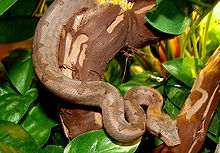
The Boidae, commonly known as boas or boids, are a family of nonvenomous snakes primarily found in the Americas, as well as Africa, Europe, Asia, and some Pacific islands. Boas include some of the world's largest snakes, with the green anaconda of South America being the heaviest and second-longest snake known; in general, adults are medium to large in size, with females usually larger than the males. Six subfamilies comprising 15 genera and 54 species are currently recognized.
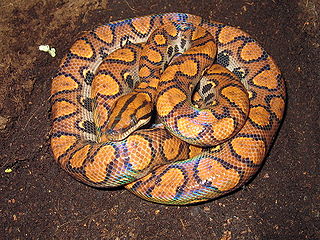
The rainbow boa is a boa species endemic to Central and South America. A semi-arboreal species, it is known for its attractive iridescent/holographic sheen caused by structural coloration. Five subspecies are currently recognized, including the nominate subspecies described here.
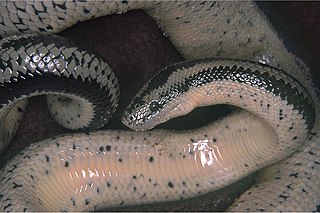
The desert rosy boa is a species of snake in the family Boidae. The desert rosy boa is native to the American Southwest and Baja California and Sonora in Mexico. The desert rosy boa is one of four species in the boa family native to the continental United States, the other three being the coastal rosy boa and the two species of rubber boas (Charina).

Candoia is a genus of non-venomous boas found mostly in New Guinea, Melanesia and the Maluku Islands in Indonesia. Common names include bevel-nosed boas and keel-scaled boas.
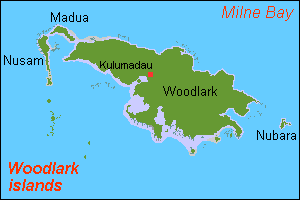
Woodlark Island, known to its inhabitants simply as Woodlark or Muyua, is the main island of the Woodlark Islands archipelago, located in Milne Bay Province and the Solomon Sea, Papua New Guinea.

Tropidophis melanurus, commonly known as the dusky dwarf boa, Cuban wood snake, or Cuban giant dwarf boa, is a nonvenomous dwarf boa species found mainly in Cuba. There are three subspecies that are recognized as being valid, including the nominate subspecies described here.

The amethystine python, also known as the scrub python or sanca permata in Indonesian, is a species of non-venomous snake in the family Pythonidae. The species is found in Indonesia and Papua New Guinea. Popular among reptile enthusiasts, and noted for its coloration and size, it is one of the largest snakes in the world, as measured either by length or weight, and is the largest native snake in Papua New Guinea. Until 2000, the larger S. kinghorni was generally considered a subspecies of S. amethistina, and this change of classification has still not been universally reflected in literature. Because of this issue, S. amethistina has often been described as the largest snake in Australia, but this is not accurate since under the current classification, this species does not occur in Australia.

The rough-scaled python is a large-scaled python species endemic to Australia. No subspecies are currently recognized.

Corallus cropanii, or Cropani's tree boa, is a species of boa, a snake in the family Boidae. The species is endemic to the state of São Paulo, Brazil. Like all boas, it is not venomous. No subspecies are currently recognized. Until 2017, no specimen of this snake had been seen alive since 1953 and only five dead specimens had been collected since then, but in late January 2017, an adult female Cropan's tree boa measuring 1.7 m was captured by locals in Ribeira who brought it to herpetologists from the Instituto Butantan and the Museum of Zoology of the University of São Paulo, who radio-tagged and released the animal to learn more about the species' behavior.

Corallus cookii, also known as Cook's tree boa or Cooke's tree boa, is a species of nonvenomous snake in the family Boidae. The species is endemic to the island of St. Vincent in the Caribbean. There are no recognized subspecies.

Eryx colubrinus, the Egyptian or Kenyan sand boa, is a species of snake in the family Boidae. The species is endemic to Northern and Eastern Africa. Three subspecies are recognized.
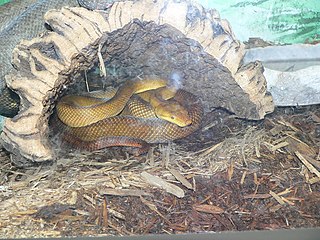
Candoia bibroni, commonly known as Bibron's bevel-nosed boa, Bibron's keel-scaled boa, the Pacific tree boa, or the Fiji boa, is a boa species endemic to Melanesia and Polynesia. Two subspecies are recognized, including the nominate subspecies described here. Like all other boas, it is not venomous.

Liasis mackloti, commonly known as Macklot's python or the freckled python, is a species of python, a non-venomous snake in the family Pythonidae. The species is endemic to Indonesia, East Timor, Papua New Guinea, and coastal northern Australia. Three subspecies are recognized, including the nominate subspecies described here.
Candoia superciliosa, known commonly as the Palau bevel-nosed boa or Belau bevel-nosed boa, is a species of snake in the Boidae family. As its common name suggests, it is found in Palau.
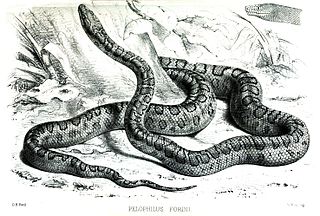
Chilabothrus fordii, also known commonly as Ford's boa and the Haitian ground boa, is a species of snake in the family Boidae. There are three recognized subspecies.

Chilabothrus striatus, the Hispaniolan boa, is a species of snake in the family Boidae. The species is endemic to Hispaniola. The species is regularly found in the international pet trade.

Eryx muelleri, known commonly as Müller's sand boa or the Saharan sand boa, is a species of snake in the family Boidae. The species is endemic to Africa. They are kept fairly regularly in the pet industry due to their docile nature and easy care.
Candoia paulsoni, also known as the Solomon Islands ground boa, is a species of boa native to the Maluku Islands and Melanesia. Five subspecies are recognized.
Chilabothrus granti, also known commonly as the Virgin Islands boa, is a species of snake in the family Boidae. The species is native to the Caribbean.

Chilabothrus strigilatus, also known commonly as the Bahamian boa, is a species of snake in the family Boidae. The species is endemic to the Bahamas. There are five recognized subspecies.
